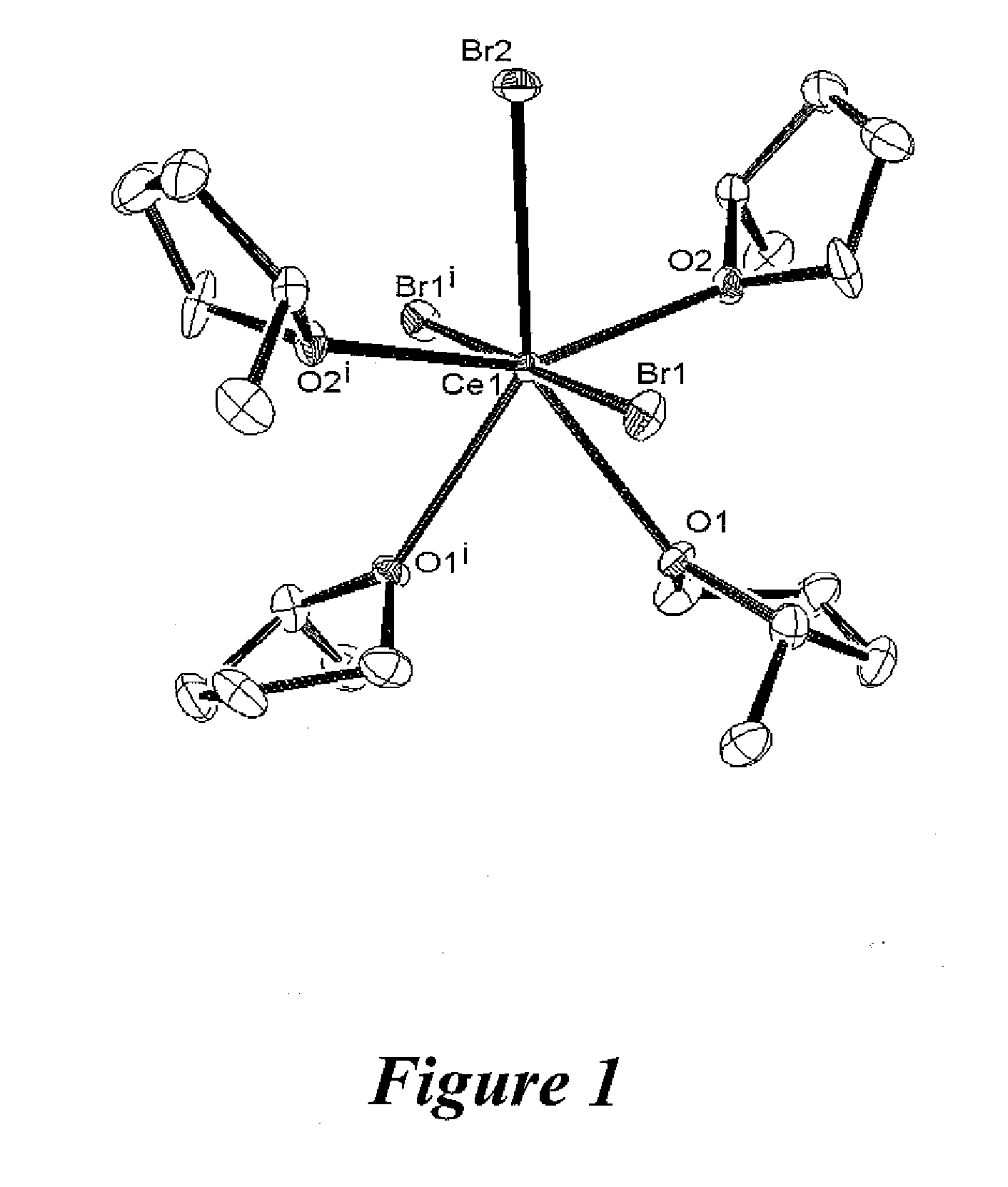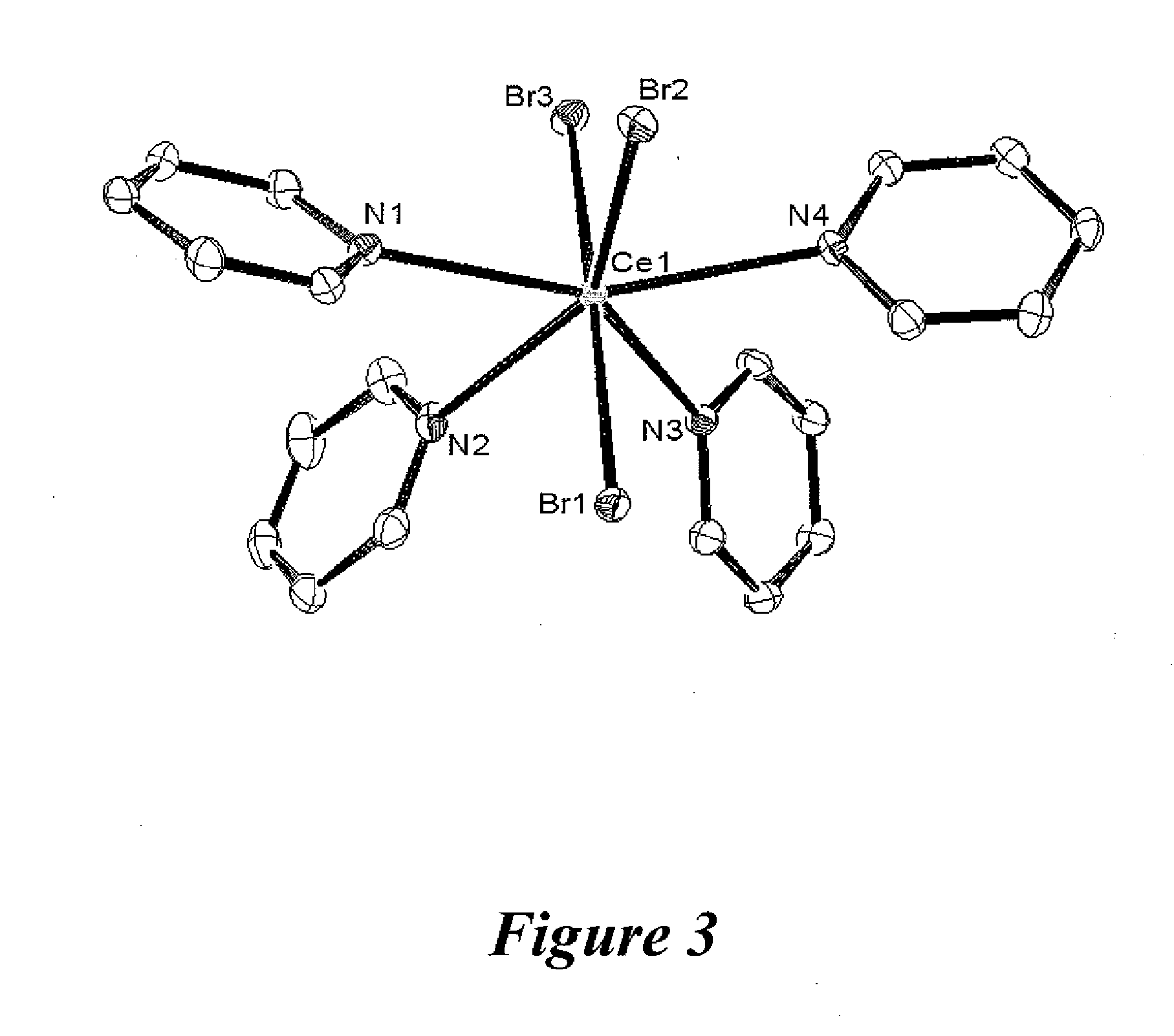Preparation of cerium halide solvate complexes
a technology of halide solvate and complexes, which is applied in the field of preparation of cerium halide solvate complexes, can solve the problems of limiting their use as suitable precursors, and achieve the effect of facilitating the conversion of a cerium halide solvate complex
- Summary
- Abstract
- Description
- Claims
- Application Information
AI Technical Summary
Benefits of technology
Problems solved by technology
Method used
Image
Examples
example 1
[0030]Preparation of a paste of CeBr3 / 1-butyl-1-methylpyrrolidinium bis(trifluoromethylsulfonyl)imide (1): CeBr3 (104.2 grams, 0.274 moles) and 1-butyl-1-methylpyrrolidinium bis(trifluoromethylsulfonyl)imide (380 milliliters) were mixed together and homogenized in a commercial blender. The mixture was introduced into a NETZSCH MINICER bead mill fitted with a peristaltic pump to allow for continuous flow. A HUBER NUEVO UNISTAT 425 chiller was used during the milling procedure to control the temperature, which was below 20° C. The mill speed was 1500 rpm, and milling time was approximately 8 hours. The product was centrifuged with a SORVALL WX ULTRA 80 centrifuge at 40,000 rpm for approximately 3 hours. After decanting the supernatant, the resulting paste (1) was approximately 40% v / v CeBr3 and 1-butyl-1-methylpyrrolidinium bis(trifluoromethylsulfonyl)imide.
example 2
[0031]Preparation of CeBr3(THF)4 2: tetrahydrofuran (“THF”) (5 milliliters) was added to 2.50 grams of the paste of prepared from EXAMPLE 1. The mixture was stirred for approximately 5 minutes. The undissolved solids were allowed to settle, and the mixture was then filtered. The clear, colorless filtrate was stored at a temperature of −35° C. for 2 days, affording a crop of colorless crystalline plate-shaped crystals. The crystals were washed with cold THF (5 ml) and dried under argon. The identity of the crystals was confirmed by matching the single-crystal X-ray diffraction unit cell to the published structure [see: Hitchcock et al., Inorg. Chem., 2004, vol. 43, pp. 1031-1038). Yield: 0.456 grams. The FT-IR spectrum included a peak at 1018 cm−1 assigned to a C—O stretch (the C—O stretch of neat THF occurs at 1070 cm−1). Analysis calculated for C16H32O4CeBr3: C (28.76%), H (4.83%). Found: C (28.45%), H (4.72%).
example 3
[0032]Preparation of CeBr3(2-Me-THF)4 (complex 3): 5 milliliters of 2-methyl-tetrahydrofuran (“2-Me-THF”) was added to 1.00 grams of the paste prepared from EXAMPLE 1. The mixture was stirred for approximately 5 minutes. The undissolved solids were allowed to settle and the supernatant was decanted away from the undissolved solids. Hexanes (1 ml) were added to the supernatant. The resulting solution was filtered. The filtrate was stored at a temperature of −35° C. for one week, affording colorless crystalline blocks of crystals of 3. The crystals of 3 were washed with cold 2-Me-THF and dried under argon. Yield (0.115 grams). The FT-IR spectrum included a peak at 1057 cm−1 assigned to a C—O stretch (the C—O stretch for neat 2-Me-THF is at 1065 cm—1). Analysis calculated for C20H40O4CeBr3: C (33.16%), H (5.57%). Found: C (20.71%), H (3.44%) corresponding to CeBr3(2-Me-THF)1.9. An ORTEP representation of 3 is shown in FIG. 1. All hydrogen atoms have been omitted for clarity.
PUM
| Property | Measurement | Unit |
|---|---|---|
| melting temperature | aaaaa | aaaaa |
| temperature | aaaaa | aaaaa |
| melting temperature | aaaaa | aaaaa |
Abstract
Description
Claims
Application Information
 Login to View More
Login to View More - R&D
- Intellectual Property
- Life Sciences
- Materials
- Tech Scout
- Unparalleled Data Quality
- Higher Quality Content
- 60% Fewer Hallucinations
Browse by: Latest US Patents, China's latest patents, Technical Efficacy Thesaurus, Application Domain, Technology Topic, Popular Technical Reports.
© 2025 PatSnap. All rights reserved.Legal|Privacy policy|Modern Slavery Act Transparency Statement|Sitemap|About US| Contact US: help@patsnap.com



